Research Proposal: Psychological Approaches to Cancer Pain Management
VerifiedAdded on 2020/03/16
|13
|3097
|80
Report
AI Summary
This report is a research proposal focused on the psychological and behavioral approaches to cancer pain management. The proposal begins with an assessment using the PICO framework to examine the effectiveness of psychological and cognitive behavioral therapy (CBT) in reducing cancer pain. It then provides a literature review, exploring the impact of psychological factors on pain perception and management, and the benefits of CBT and psychological interventions. The proposal outlines the research aim, questions, and methodology, including the use of databases like PsycArticles and Medline Plus. The research aims to examine the psychological factors affecting pain from diagnosis through treatment, survival, and end-of-life care. The conclusion highlights the importance of psychological factors and interventions in cancer pain management. The report also includes a comprehensive list of references supporting the research.
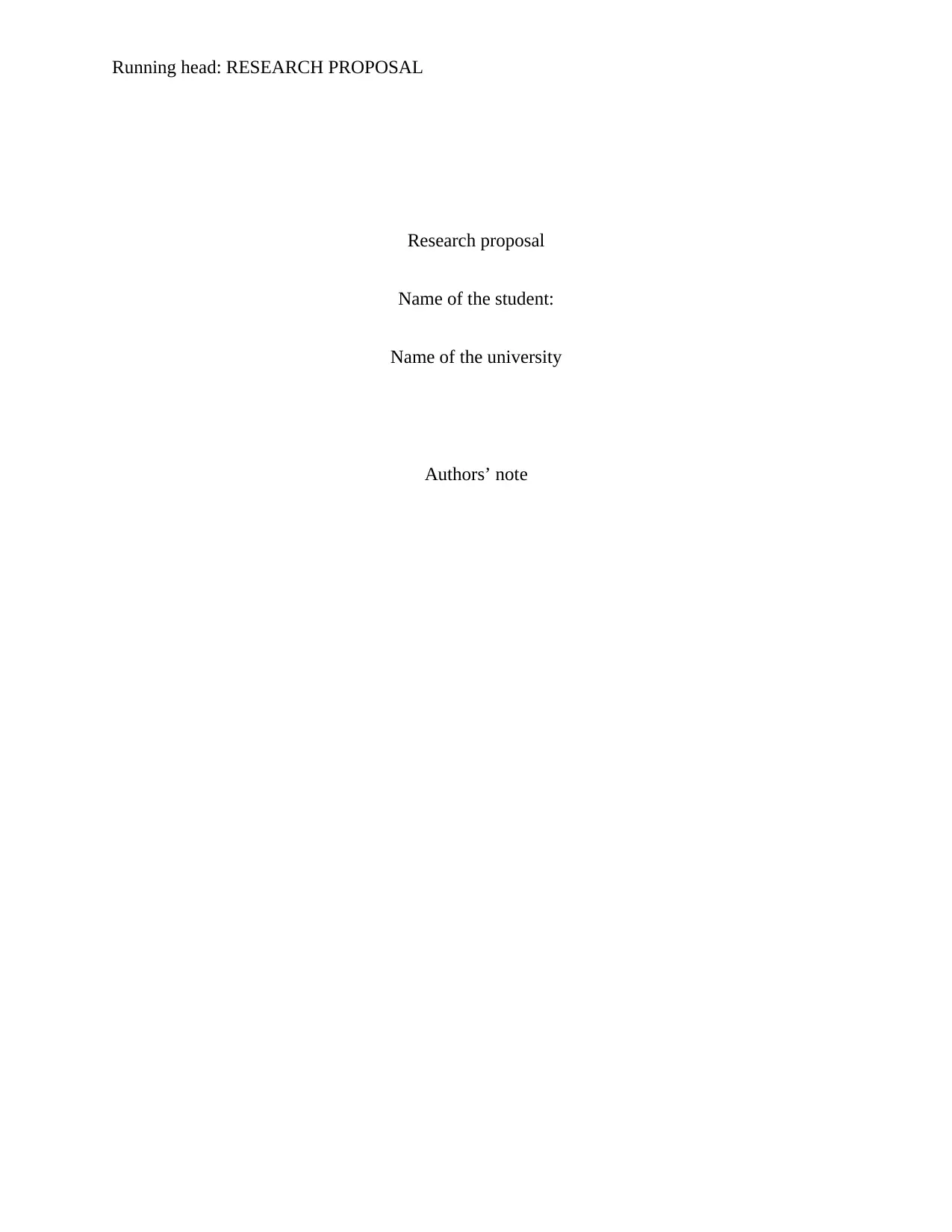
Running head: RESEARCH PROPOSAL
Research proposal
Name of the student:
Name of the university
Authors’ note
Research proposal
Name of the student:
Name of the university
Authors’ note
Paraphrase This Document
Need a fresh take? Get an instant paraphrase of this document with our AI Paraphraser
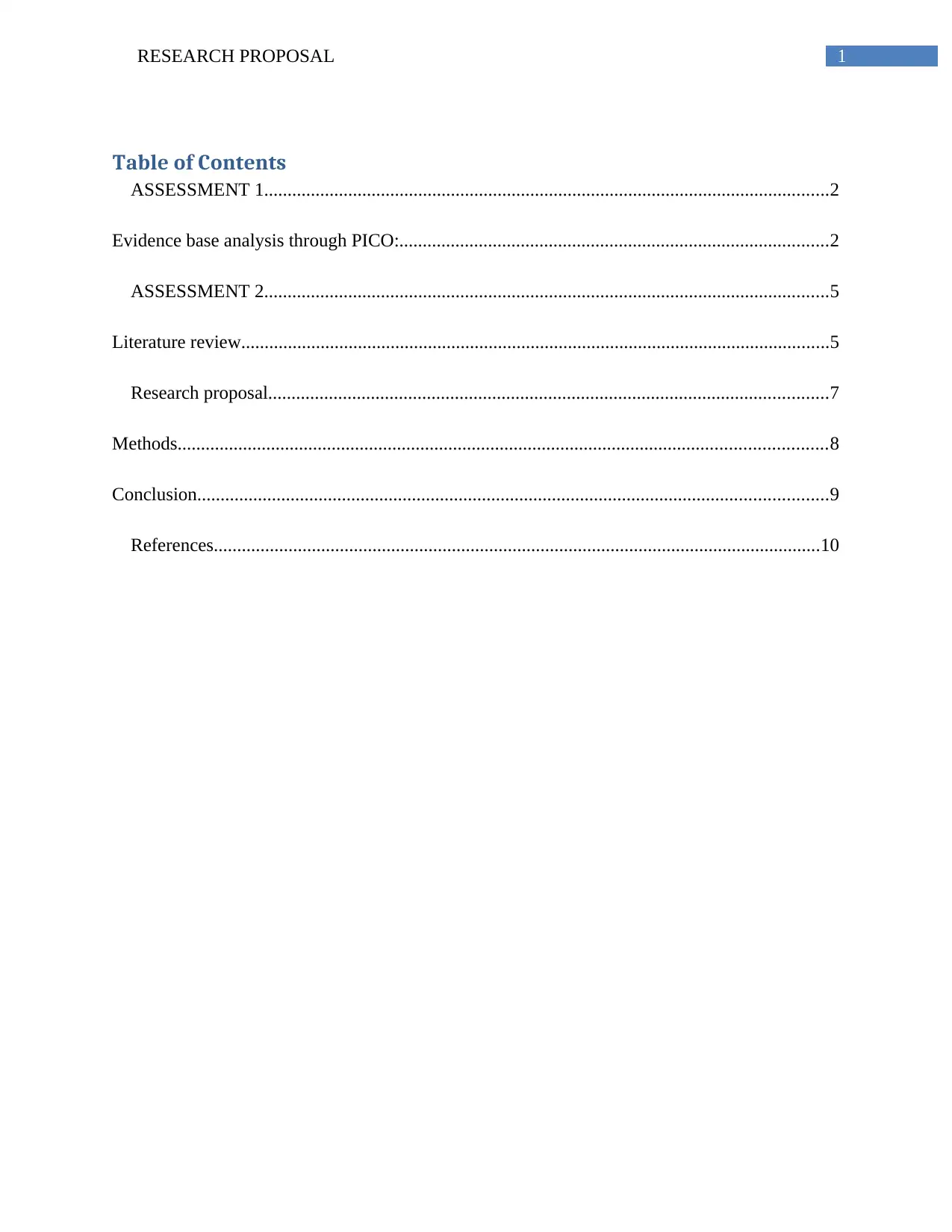
1RESEARCH PROPOSAL
Table of Contents
ASSESSMENT 1.........................................................................................................................2
Evidence base analysis through PICO:............................................................................................2
ASSESSMENT 2.........................................................................................................................5
Literature review..............................................................................................................................5
Research proposal........................................................................................................................7
Methods...........................................................................................................................................8
Conclusion.......................................................................................................................................9
References..................................................................................................................................10
Table of Contents
ASSESSMENT 1.........................................................................................................................2
Evidence base analysis through PICO:............................................................................................2
ASSESSMENT 2.........................................................................................................................5
Literature review..............................................................................................................................5
Research proposal........................................................................................................................7
Methods...........................................................................................................................................8
Conclusion.......................................................................................................................................9
References..................................................................................................................................10
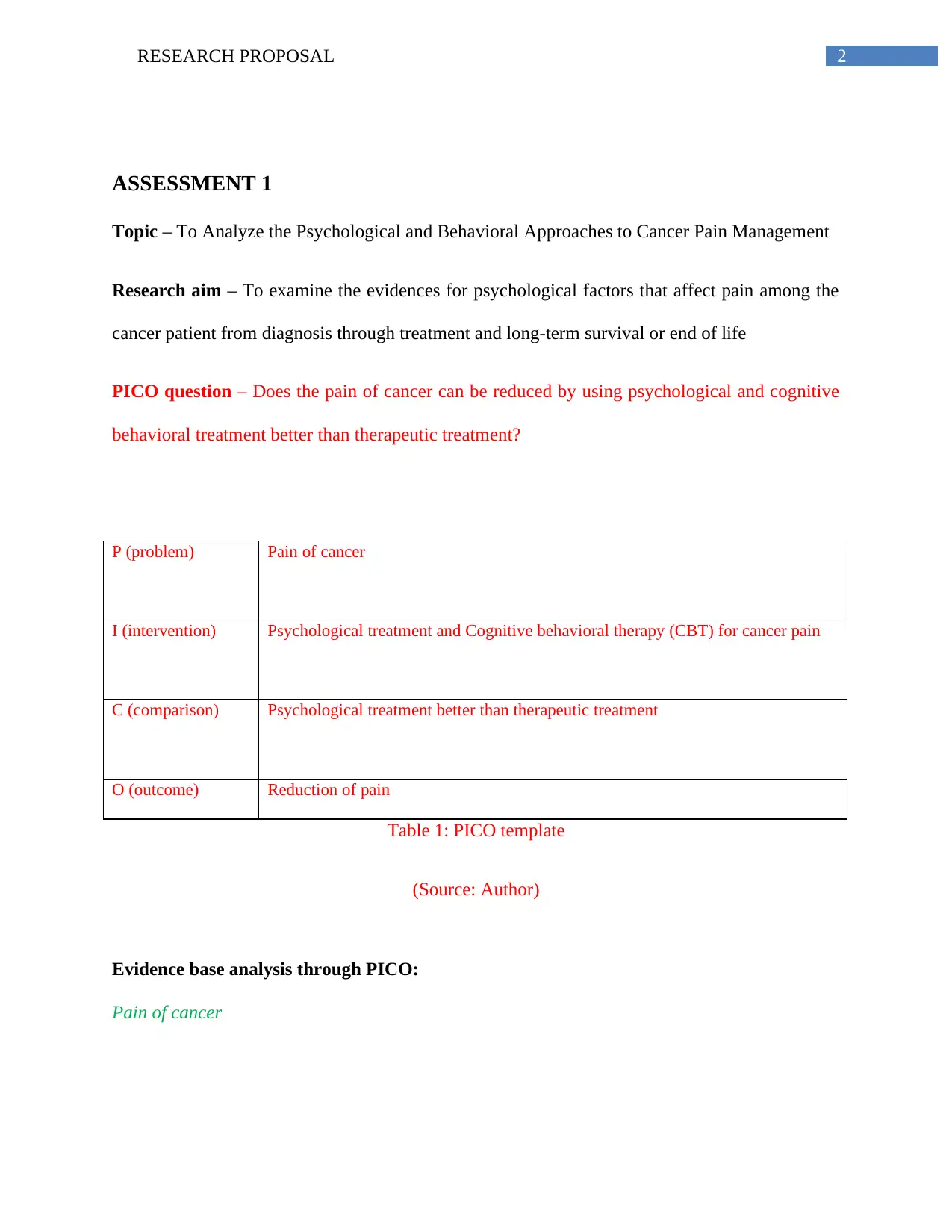
2RESEARCH PROPOSAL
ASSESSMENT 1
Topic – To Analyze the Psychological and Behavioral Approaches to Cancer Pain Management
Research aim – To examine the evidences for psychological factors that affect pain among the
cancer patient from diagnosis through treatment and long-term survival or end of life
PICO question – Does the pain of cancer can be reduced by using psychological and cognitive
behavioral treatment better than therapeutic treatment?
P (problem) Pain of cancer
I (intervention) Psychological treatment and Cognitive behavioral therapy (CBT) for cancer pain
C (comparison) Psychological treatment better than therapeutic treatment
O (outcome) Reduction of pain
Table 1: PICO template
(Source: Author)
Evidence base analysis through PICO:
Pain of cancer
ASSESSMENT 1
Topic – To Analyze the Psychological and Behavioral Approaches to Cancer Pain Management
Research aim – To examine the evidences for psychological factors that affect pain among the
cancer patient from diagnosis through treatment and long-term survival or end of life
PICO question – Does the pain of cancer can be reduced by using psychological and cognitive
behavioral treatment better than therapeutic treatment?
P (problem) Pain of cancer
I (intervention) Psychological treatment and Cognitive behavioral therapy (CBT) for cancer pain
C (comparison) Psychological treatment better than therapeutic treatment
O (outcome) Reduction of pain
Table 1: PICO template
(Source: Author)
Evidence base analysis through PICO:
Pain of cancer
⊘ This is a preview!⊘
Do you want full access?
Subscribe today to unlock all pages.

Trusted by 1+ million students worldwide
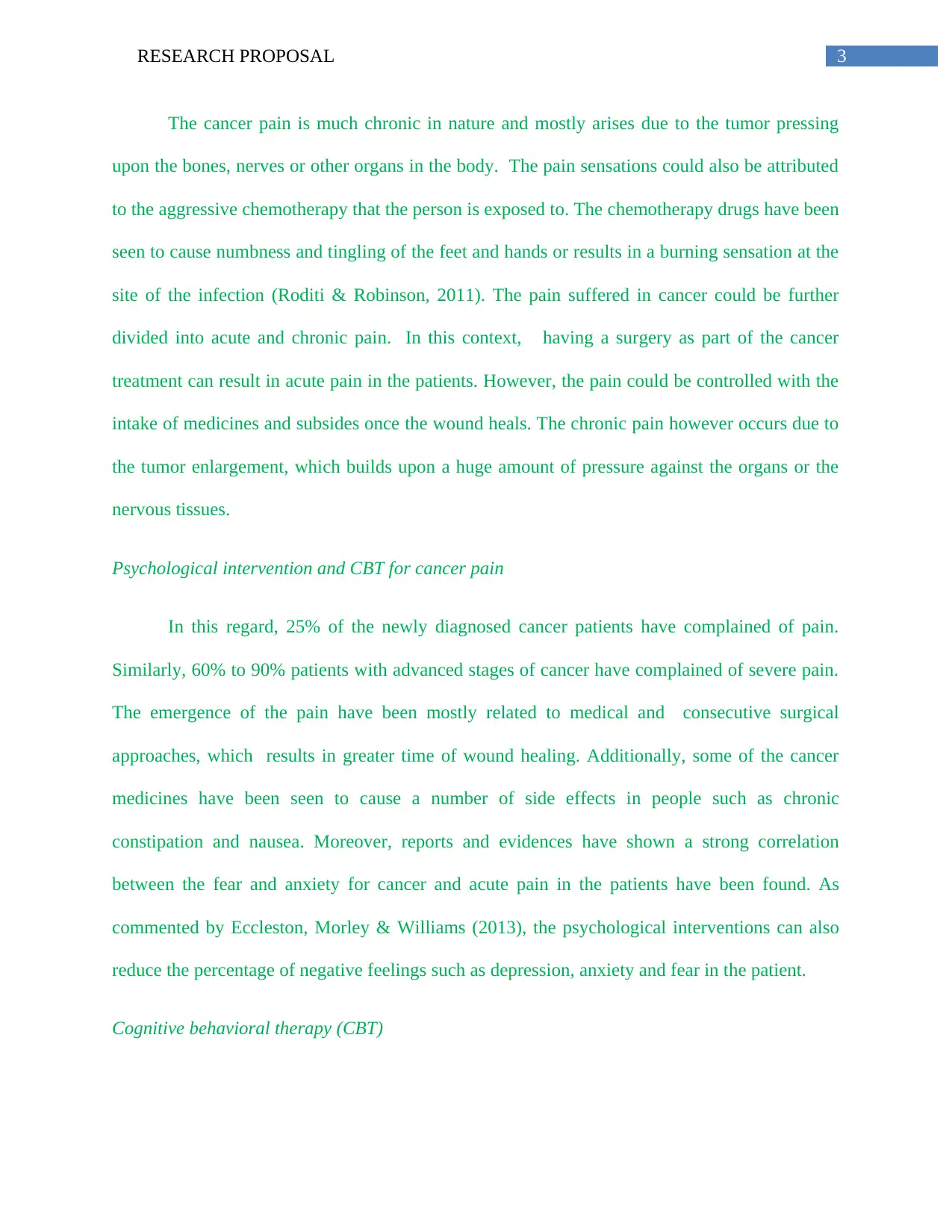
3RESEARCH PROPOSAL
The cancer pain is much chronic in nature and mostly arises due to the tumor pressing
upon the bones, nerves or other organs in the body. The pain sensations could also be attributed
to the aggressive chemotherapy that the person is exposed to. The chemotherapy drugs have been
seen to cause numbness and tingling of the feet and hands or results in a burning sensation at the
site of the infection (Roditi & Robinson, 2011). The pain suffered in cancer could be further
divided into acute and chronic pain. In this context, having a surgery as part of the cancer
treatment can result in acute pain in the patients. However, the pain could be controlled with the
intake of medicines and subsides once the wound heals. The chronic pain however occurs due to
the tumor enlargement, which builds upon a huge amount of pressure against the organs or the
nervous tissues.
Psychological intervention and CBT for cancer pain
In this regard, 25% of the newly diagnosed cancer patients have complained of pain.
Similarly, 60% to 90% patients with advanced stages of cancer have complained of severe pain.
The emergence of the pain have been mostly related to medical and consecutive surgical
approaches, which results in greater time of wound healing. Additionally, some of the cancer
medicines have been seen to cause a number of side effects in people such as chronic
constipation and nausea. Moreover, reports and evidences have shown a strong correlation
between the fear and anxiety for cancer and acute pain in the patients have been found. As
commented by Eccleston, Morley & Williams (2013), the psychological interventions can also
reduce the percentage of negative feelings such as depression, anxiety and fear in the patient.
Cognitive behavioral therapy (CBT)
The cancer pain is much chronic in nature and mostly arises due to the tumor pressing
upon the bones, nerves or other organs in the body. The pain sensations could also be attributed
to the aggressive chemotherapy that the person is exposed to. The chemotherapy drugs have been
seen to cause numbness and tingling of the feet and hands or results in a burning sensation at the
site of the infection (Roditi & Robinson, 2011). The pain suffered in cancer could be further
divided into acute and chronic pain. In this context, having a surgery as part of the cancer
treatment can result in acute pain in the patients. However, the pain could be controlled with the
intake of medicines and subsides once the wound heals. The chronic pain however occurs due to
the tumor enlargement, which builds upon a huge amount of pressure against the organs or the
nervous tissues.
Psychological intervention and CBT for cancer pain
In this regard, 25% of the newly diagnosed cancer patients have complained of pain.
Similarly, 60% to 90% patients with advanced stages of cancer have complained of severe pain.
The emergence of the pain have been mostly related to medical and consecutive surgical
approaches, which results in greater time of wound healing. Additionally, some of the cancer
medicines have been seen to cause a number of side effects in people such as chronic
constipation and nausea. Moreover, reports and evidences have shown a strong correlation
between the fear and anxiety for cancer and acute pain in the patients have been found. As
commented by Eccleston, Morley & Williams (2013), the psychological interventions can also
reduce the percentage of negative feelings such as depression, anxiety and fear in the patient.
Cognitive behavioral therapy (CBT)
Paraphrase This Document
Need a fresh take? Get an instant paraphrase of this document with our AI Paraphraser
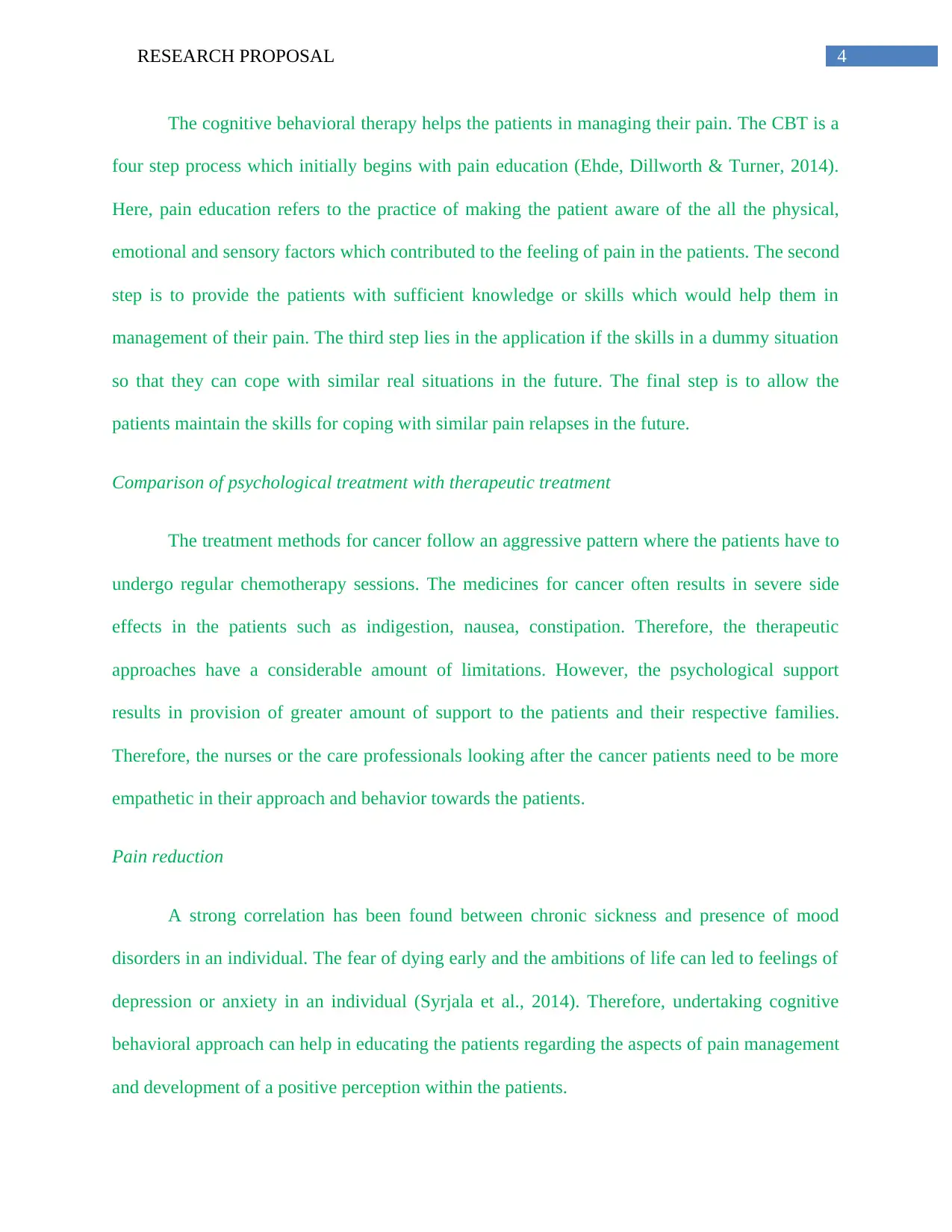
4RESEARCH PROPOSAL
The cognitive behavioral therapy helps the patients in managing their pain. The CBT is a
four step process which initially begins with pain education (Ehde, Dillworth & Turner, 2014).
Here, pain education refers to the practice of making the patient aware of the all the physical,
emotional and sensory factors which contributed to the feeling of pain in the patients. The second
step is to provide the patients with sufficient knowledge or skills which would help them in
management of their pain. The third step lies in the application if the skills in a dummy situation
so that they can cope with similar real situations in the future. The final step is to allow the
patients maintain the skills for coping with similar pain relapses in the future.
Comparison of psychological treatment with therapeutic treatment
The treatment methods for cancer follow an aggressive pattern where the patients have to
undergo regular chemotherapy sessions. The medicines for cancer often results in severe side
effects in the patients such as indigestion, nausea, constipation. Therefore, the therapeutic
approaches have a considerable amount of limitations. However, the psychological support
results in provision of greater amount of support to the patients and their respective families.
Therefore, the nurses or the care professionals looking after the cancer patients need to be more
empathetic in their approach and behavior towards the patients.
Pain reduction
A strong correlation has been found between chronic sickness and presence of mood
disorders in an individual. The fear of dying early and the ambitions of life can led to feelings of
depression or anxiety in an individual (Syrjala et al., 2014). Therefore, undertaking cognitive
behavioral approach can help in educating the patients regarding the aspects of pain management
and development of a positive perception within the patients.
The cognitive behavioral therapy helps the patients in managing their pain. The CBT is a
four step process which initially begins with pain education (Ehde, Dillworth & Turner, 2014).
Here, pain education refers to the practice of making the patient aware of the all the physical,
emotional and sensory factors which contributed to the feeling of pain in the patients. The second
step is to provide the patients with sufficient knowledge or skills which would help them in
management of their pain. The third step lies in the application if the skills in a dummy situation
so that they can cope with similar real situations in the future. The final step is to allow the
patients maintain the skills for coping with similar pain relapses in the future.
Comparison of psychological treatment with therapeutic treatment
The treatment methods for cancer follow an aggressive pattern where the patients have to
undergo regular chemotherapy sessions. The medicines for cancer often results in severe side
effects in the patients such as indigestion, nausea, constipation. Therefore, the therapeutic
approaches have a considerable amount of limitations. However, the psychological support
results in provision of greater amount of support to the patients and their respective families.
Therefore, the nurses or the care professionals looking after the cancer patients need to be more
empathetic in their approach and behavior towards the patients.
Pain reduction
A strong correlation has been found between chronic sickness and presence of mood
disorders in an individual. The fear of dying early and the ambitions of life can led to feelings of
depression or anxiety in an individual (Syrjala et al., 2014). Therefore, undertaking cognitive
behavioral approach can help in educating the patients regarding the aspects of pain management
and development of a positive perception within the patients.
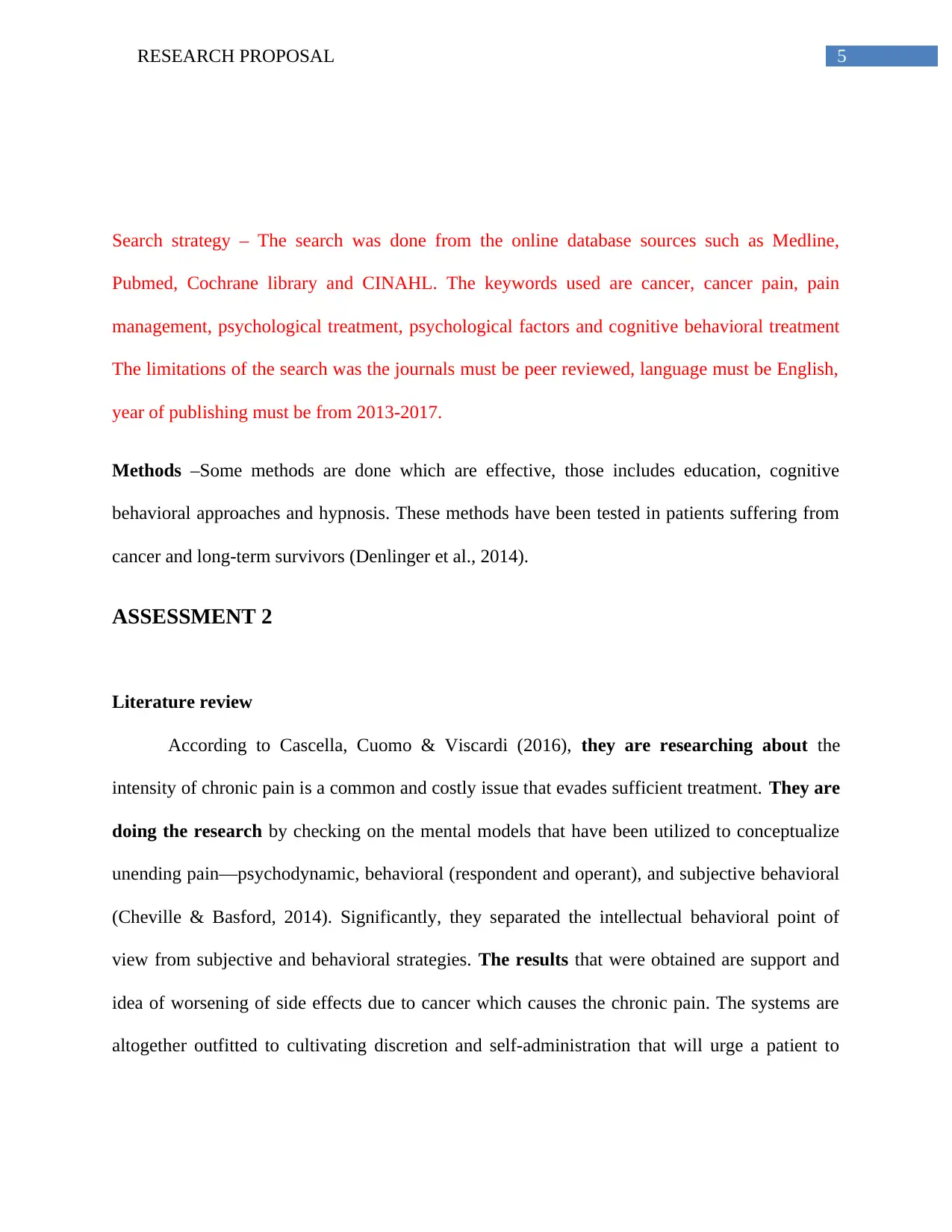
5RESEARCH PROPOSAL
Search strategy – The search was done from the online database sources such as Medline,
Pubmed, Cochrane library and CINAHL. The keywords used are cancer, cancer pain, pain
management, psychological treatment, psychological factors and cognitive behavioral treatment
The limitations of the search was the journals must be peer reviewed, language must be English,
year of publishing must be from 2013-2017.
Methods –Some methods are done which are effective, those includes education, cognitive
behavioral approaches and hypnosis. These methods have been tested in patients suffering from
cancer and long-term survivors (Denlinger et al., 2014).
ASSESSMENT 2
Literature review
According to Cascella, Cuomo & Viscardi (2016), they are researching about the
intensity of chronic pain is a common and costly issue that evades sufficient treatment. They are
doing the research by checking on the mental models that have been utilized to conceptualize
unending pain—psychodynamic, behavioral (respondent and operant), and subjective behavioral
(Cheville & Basford, 2014). Significantly, they separated the intellectual behavioral point of
view from subjective and behavioral strategies. The results that were obtained are support and
idea of worsening of side effects due to cancer which causes the chronic pain. The systems are
altogether outfitted to cultivating discretion and self-administration that will urge a patient to
Search strategy – The search was done from the online database sources such as Medline,
Pubmed, Cochrane library and CINAHL. The keywords used are cancer, cancer pain, pain
management, psychological treatment, psychological factors and cognitive behavioral treatment
The limitations of the search was the journals must be peer reviewed, language must be English,
year of publishing must be from 2013-2017.
Methods –Some methods are done which are effective, those includes education, cognitive
behavioral approaches and hypnosis. These methods have been tested in patients suffering from
cancer and long-term survivors (Denlinger et al., 2014).
ASSESSMENT 2
Literature review
According to Cascella, Cuomo & Viscardi (2016), they are researching about the
intensity of chronic pain is a common and costly issue that evades sufficient treatment. They are
doing the research by checking on the mental models that have been utilized to conceptualize
unending pain—psychodynamic, behavioral (respondent and operant), and subjective behavioral
(Cheville & Basford, 2014). Significantly, they separated the intellectual behavioral point of
view from subjective and behavioral strategies. The results that were obtained are support and
idea of worsening of side effects due to cancer which causes the chronic pain. The systems are
altogether outfitted to cultivating discretion and self-administration that will urge a patient to
⊘ This is a preview!⊘
Do you want full access?
Subscribe today to unlock all pages.

Trusted by 1+ million students worldwide
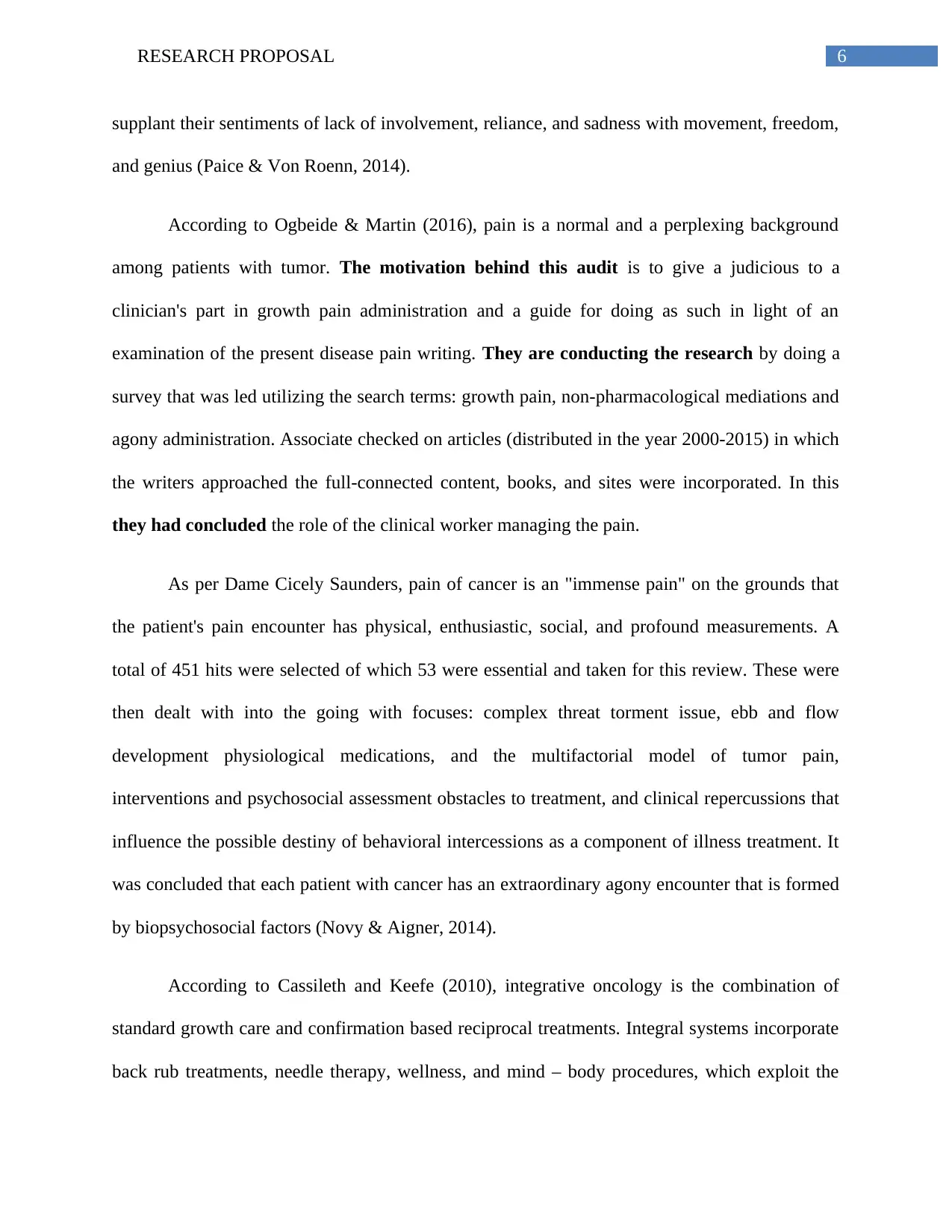
6RESEARCH PROPOSAL
supplant their sentiments of lack of involvement, reliance, and sadness with movement, freedom,
and genius (Paice & Von Roenn, 2014).
According to Ogbeide & Martin (2016), pain is a normal and a perplexing background
among patients with tumor. The motivation behind this audit is to give a judicious to a
clinician's part in growth pain administration and a guide for doing as such in light of an
examination of the present disease pain writing. They are conducting the research by doing a
survey that was led utilizing the search terms: growth pain, non-pharmacological mediations and
agony administration. Associate checked on articles (distributed in the year 2000-2015) in which
the writers approached the full-connected content, books, and sites were incorporated. In this
they had concluded the role of the clinical worker managing the pain.
As per Dame Cicely Saunders, pain of cancer is an "immense pain" on the grounds that
the patient's pain encounter has physical, enthusiastic, social, and profound measurements. A
total of 451 hits were selected of which 53 were essential and taken for this review. These were
then dealt with into the going with focuses: complex threat torment issue, ebb and flow
development physiological medications, and the multifactorial model of tumor pain,
interventions and psychosocial assessment obstacles to treatment, and clinical repercussions that
influence the possible destiny of behavioral intercessions as a component of illness treatment. It
was concluded that each patient with cancer has an extraordinary agony encounter that is formed
by biopsychosocial factors (Novy & Aigner, 2014).
According to Cassileth and Keefe (2010), integrative oncology is the combination of
standard growth care and confirmation based reciprocal treatments. Integral systems incorporate
back rub treatments, needle therapy, wellness, and mind – body procedures, which exploit the
supplant their sentiments of lack of involvement, reliance, and sadness with movement, freedom,
and genius (Paice & Von Roenn, 2014).
According to Ogbeide & Martin (2016), pain is a normal and a perplexing background
among patients with tumor. The motivation behind this audit is to give a judicious to a
clinician's part in growth pain administration and a guide for doing as such in light of an
examination of the present disease pain writing. They are conducting the research by doing a
survey that was led utilizing the search terms: growth pain, non-pharmacological mediations and
agony administration. Associate checked on articles (distributed in the year 2000-2015) in which
the writers approached the full-connected content, books, and sites were incorporated. In this
they had concluded the role of the clinical worker managing the pain.
As per Dame Cicely Saunders, pain of cancer is an "immense pain" on the grounds that
the patient's pain encounter has physical, enthusiastic, social, and profound measurements. A
total of 451 hits were selected of which 53 were essential and taken for this review. These were
then dealt with into the going with focuses: complex threat torment issue, ebb and flow
development physiological medications, and the multifactorial model of tumor pain,
interventions and psychosocial assessment obstacles to treatment, and clinical repercussions that
influence the possible destiny of behavioral intercessions as a component of illness treatment. It
was concluded that each patient with cancer has an extraordinary agony encounter that is formed
by biopsychosocial factors (Novy & Aigner, 2014).
According to Cassileth and Keefe (2010), integrative oncology is the combination of
standard growth care and confirmation based reciprocal treatments. Integral systems incorporate
back rub treatments, needle therapy, wellness, and mind – body procedures, which exploit the
Paraphrase This Document
Need a fresh take? Get an instant paraphrase of this document with our AI Paraphraser
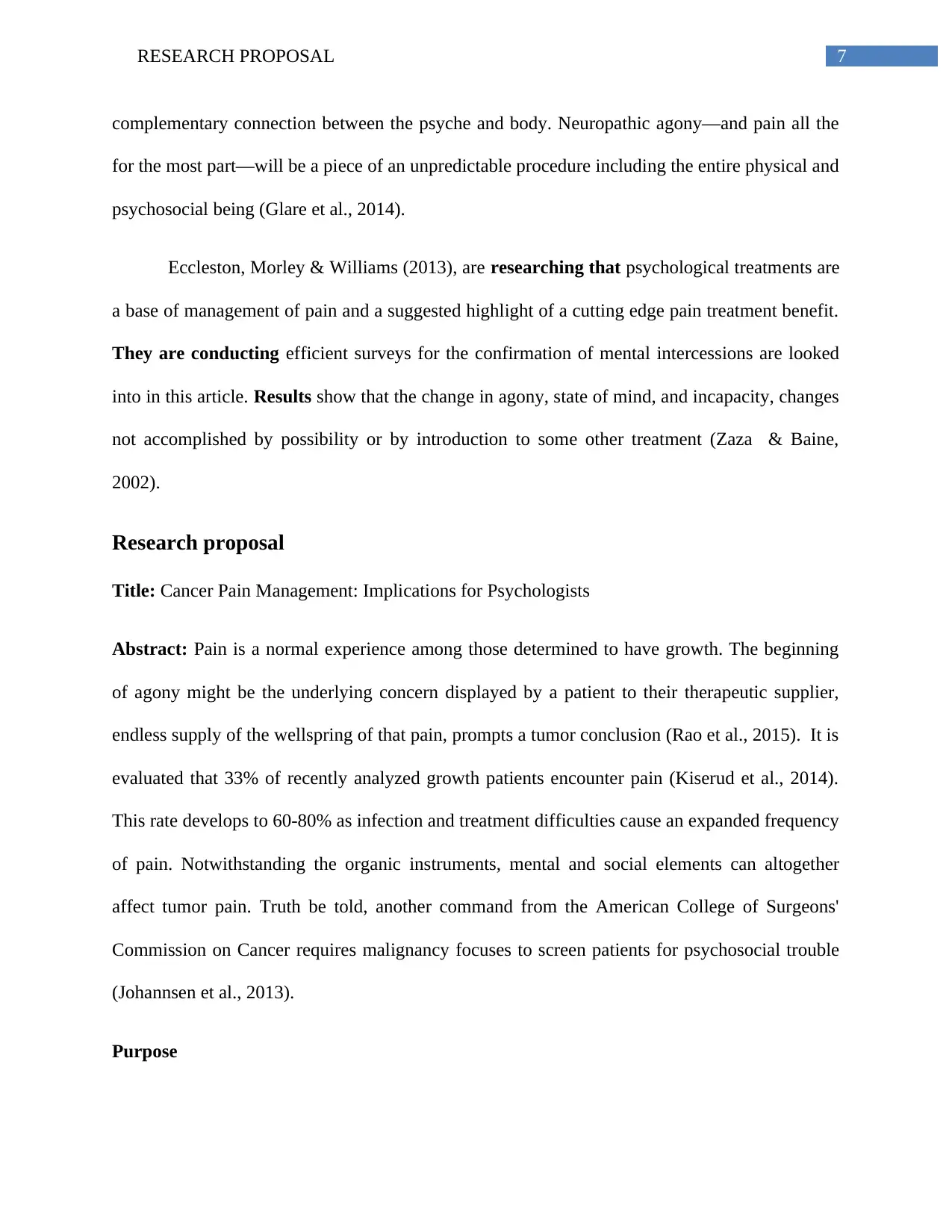
7RESEARCH PROPOSAL
complementary connection between the psyche and body. Neuropathic agony—and pain all the
for the most part—will be a piece of an unpredictable procedure including the entire physical and
psychosocial being (Glare et al., 2014).
Eccleston, Morley & Williams (2013), are researching that psychological treatments are
a base of management of pain and a suggested highlight of a cutting edge pain treatment benefit.
They are conducting efficient surveys for the confirmation of mental intercessions are looked
into in this article. Results show that the change in agony, state of mind, and incapacity, changes
not accomplished by possibility or by introduction to some other treatment (Zaza & Baine,
2002).
Research proposal
Title: Cancer Pain Management: Implications for Psychologists
Abstract: Pain is a normal experience among those determined to have growth. The beginning
of agony might be the underlying concern displayed by a patient to their therapeutic supplier,
endless supply of the wellspring of that pain, prompts a tumor conclusion (Rao et al., 2015). It is
evaluated that 33% of recently analyzed growth patients encounter pain (Kiserud et al., 2014).
This rate develops to 60-80% as infection and treatment difficulties cause an expanded frequency
of pain. Notwithstanding the organic instruments, mental and social elements can altogether
affect tumor pain. Truth be told, another command from the American College of Surgeons'
Commission on Cancer requires malignancy focuses to screen patients for psychosocial trouble
(Johannsen et al., 2013).
Purpose
complementary connection between the psyche and body. Neuropathic agony—and pain all the
for the most part—will be a piece of an unpredictable procedure including the entire physical and
psychosocial being (Glare et al., 2014).
Eccleston, Morley & Williams (2013), are researching that psychological treatments are
a base of management of pain and a suggested highlight of a cutting edge pain treatment benefit.
They are conducting efficient surveys for the confirmation of mental intercessions are looked
into in this article. Results show that the change in agony, state of mind, and incapacity, changes
not accomplished by possibility or by introduction to some other treatment (Zaza & Baine,
2002).
Research proposal
Title: Cancer Pain Management: Implications for Psychologists
Abstract: Pain is a normal experience among those determined to have growth. The beginning
of agony might be the underlying concern displayed by a patient to their therapeutic supplier,
endless supply of the wellspring of that pain, prompts a tumor conclusion (Rao et al., 2015). It is
evaluated that 33% of recently analyzed growth patients encounter pain (Kiserud et al., 2014).
This rate develops to 60-80% as infection and treatment difficulties cause an expanded frequency
of pain. Notwithstanding the organic instruments, mental and social elements can altogether
affect tumor pain. Truth be told, another command from the American College of Surgeons'
Commission on Cancer requires malignancy focuses to screen patients for psychosocial trouble
(Johannsen et al., 2013).
Purpose
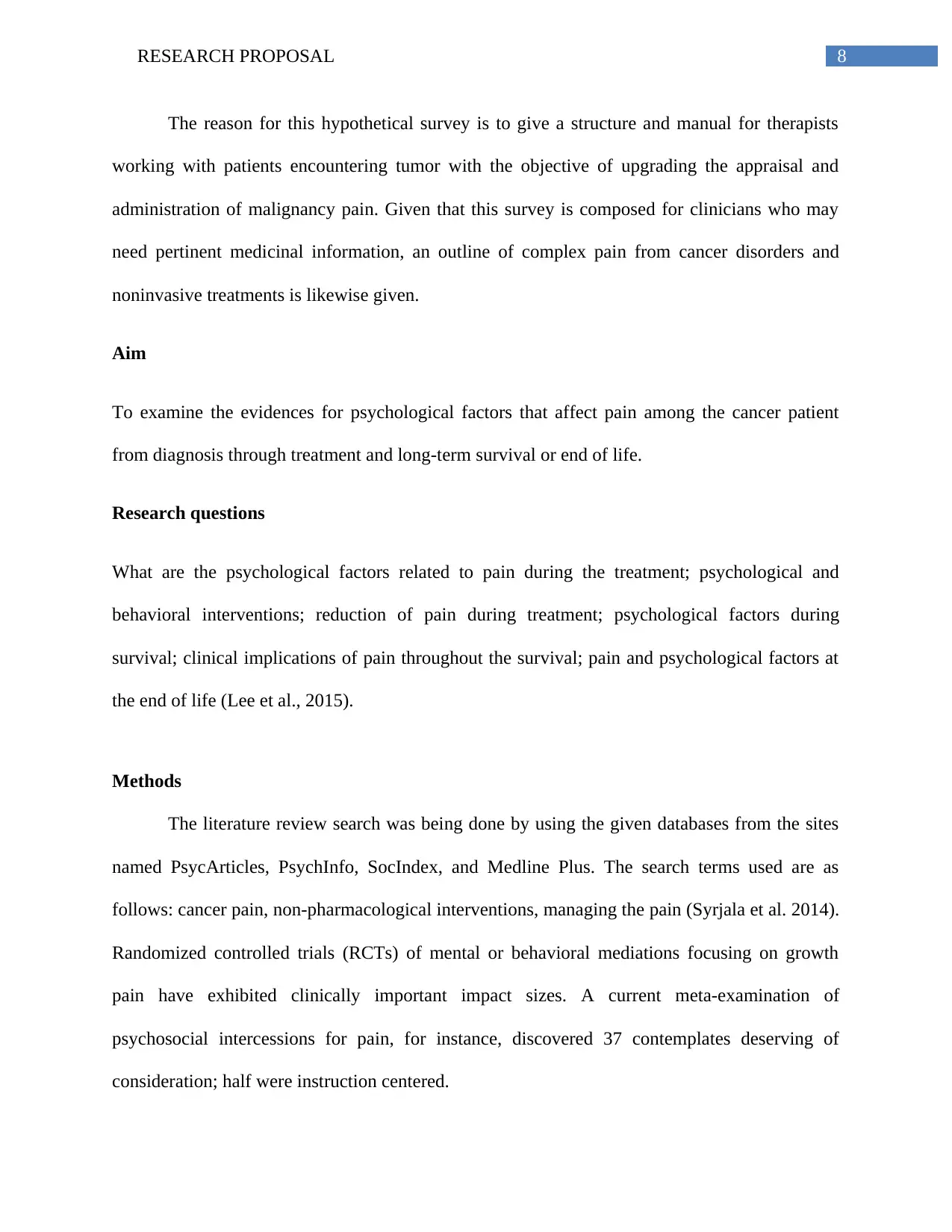
8RESEARCH PROPOSAL
The reason for this hypothetical survey is to give a structure and manual for therapists
working with patients encountering tumor with the objective of upgrading the appraisal and
administration of malignancy pain. Given that this survey is composed for clinicians who may
need pertinent medicinal information, an outline of complex pain from cancer disorders and
noninvasive treatments is likewise given.
Aim
To examine the evidences for psychological factors that affect pain among the cancer patient
from diagnosis through treatment and long-term survival or end of life.
Research questions
What are the psychological factors related to pain during the treatment; psychological and
behavioral interventions; reduction of pain during treatment; psychological factors during
survival; clinical implications of pain throughout the survival; pain and psychological factors at
the end of life (Lee et al., 2015).
Methods
The literature review search was being done by using the given databases from the sites
named PsycArticles, PsychInfo, SocIndex, and Medline Plus. The search terms used are as
follows: cancer pain, non-pharmacological interventions, managing the pain (Syrjala et al. 2014).
Randomized controlled trials (RCTs) of mental or behavioral mediations focusing on growth
pain have exhibited clinically important impact sizes. A current meta-examination of
psychosocial intercessions for pain, for instance, discovered 37 contemplates deserving of
consideration; half were instruction centered.
The reason for this hypothetical survey is to give a structure and manual for therapists
working with patients encountering tumor with the objective of upgrading the appraisal and
administration of malignancy pain. Given that this survey is composed for clinicians who may
need pertinent medicinal information, an outline of complex pain from cancer disorders and
noninvasive treatments is likewise given.
Aim
To examine the evidences for psychological factors that affect pain among the cancer patient
from diagnosis through treatment and long-term survival or end of life.
Research questions
What are the psychological factors related to pain during the treatment; psychological and
behavioral interventions; reduction of pain during treatment; psychological factors during
survival; clinical implications of pain throughout the survival; pain and psychological factors at
the end of life (Lee et al., 2015).
Methods
The literature review search was being done by using the given databases from the sites
named PsycArticles, PsychInfo, SocIndex, and Medline Plus. The search terms used are as
follows: cancer pain, non-pharmacological interventions, managing the pain (Syrjala et al. 2014).
Randomized controlled trials (RCTs) of mental or behavioral mediations focusing on growth
pain have exhibited clinically important impact sizes. A current meta-examination of
psychosocial intercessions for pain, for instance, discovered 37 contemplates deserving of
consideration; half were instruction centered.
⊘ This is a preview!⊘
Do you want full access?
Subscribe today to unlock all pages.

Trusted by 1+ million students worldwide
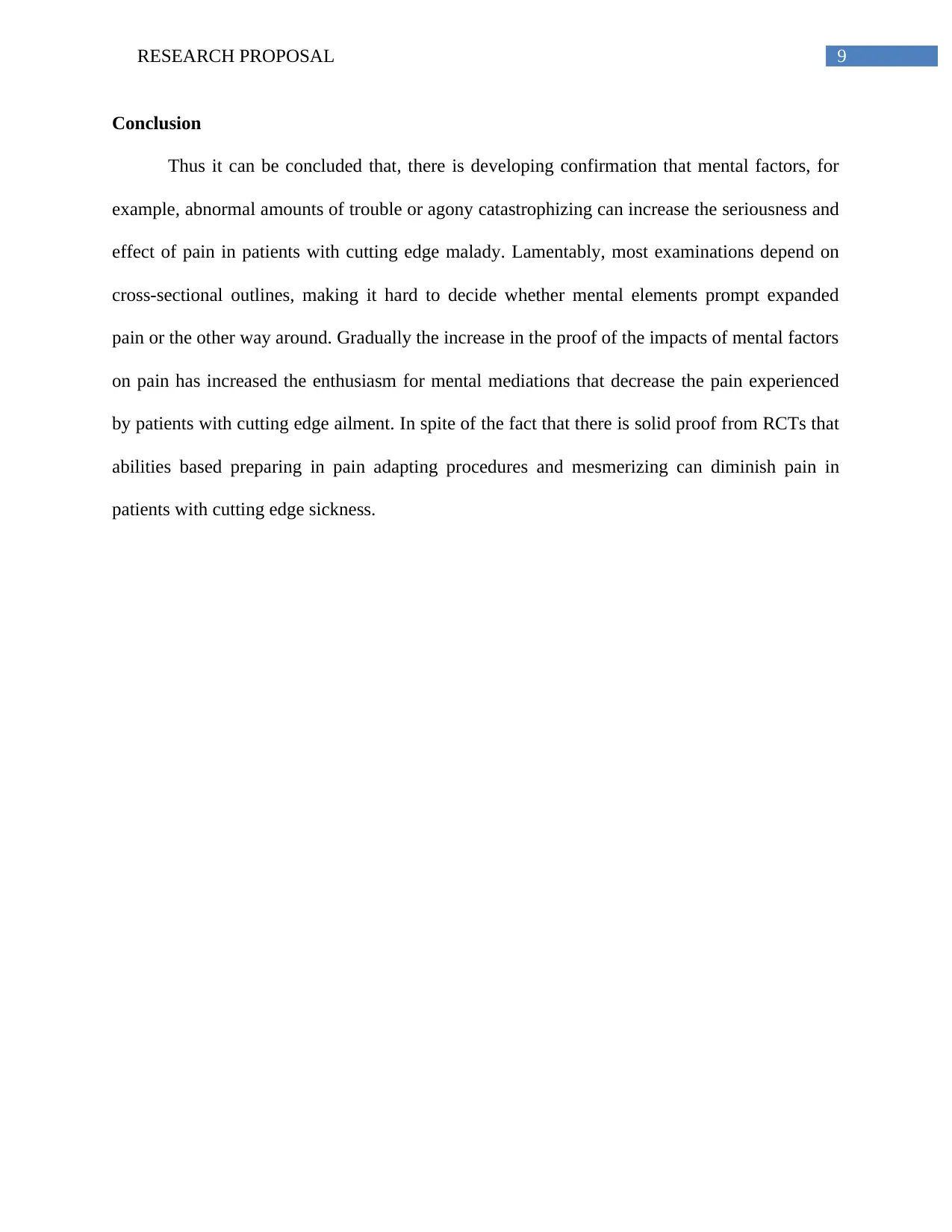
9RESEARCH PROPOSAL
Conclusion
Thus it can be concluded that, there is developing confirmation that mental factors, for
example, abnormal amounts of trouble or agony catastrophizing can increase the seriousness and
effect of pain in patients with cutting edge malady. Lamentably, most examinations depend on
cross-sectional outlines, making it hard to decide whether mental elements prompt expanded
pain or the other way around. Gradually the increase in the proof of the impacts of mental factors
on pain has increased the enthusiasm for mental mediations that decrease the pain experienced
by patients with cutting edge ailment. In spite of the fact that there is solid proof from RCTs that
abilities based preparing in pain adapting procedures and mesmerizing can diminish pain in
patients with cutting edge sickness.
Conclusion
Thus it can be concluded that, there is developing confirmation that mental factors, for
example, abnormal amounts of trouble or agony catastrophizing can increase the seriousness and
effect of pain in patients with cutting edge malady. Lamentably, most examinations depend on
cross-sectional outlines, making it hard to decide whether mental elements prompt expanded
pain or the other way around. Gradually the increase in the proof of the impacts of mental factors
on pain has increased the enthusiasm for mental mediations that decrease the pain experienced
by patients with cutting edge ailment. In spite of the fact that there is solid proof from RCTs that
abilities based preparing in pain adapting procedures and mesmerizing can diminish pain in
patients with cutting edge sickness.
Paraphrase This Document
Need a fresh take? Get an instant paraphrase of this document with our AI Paraphraser
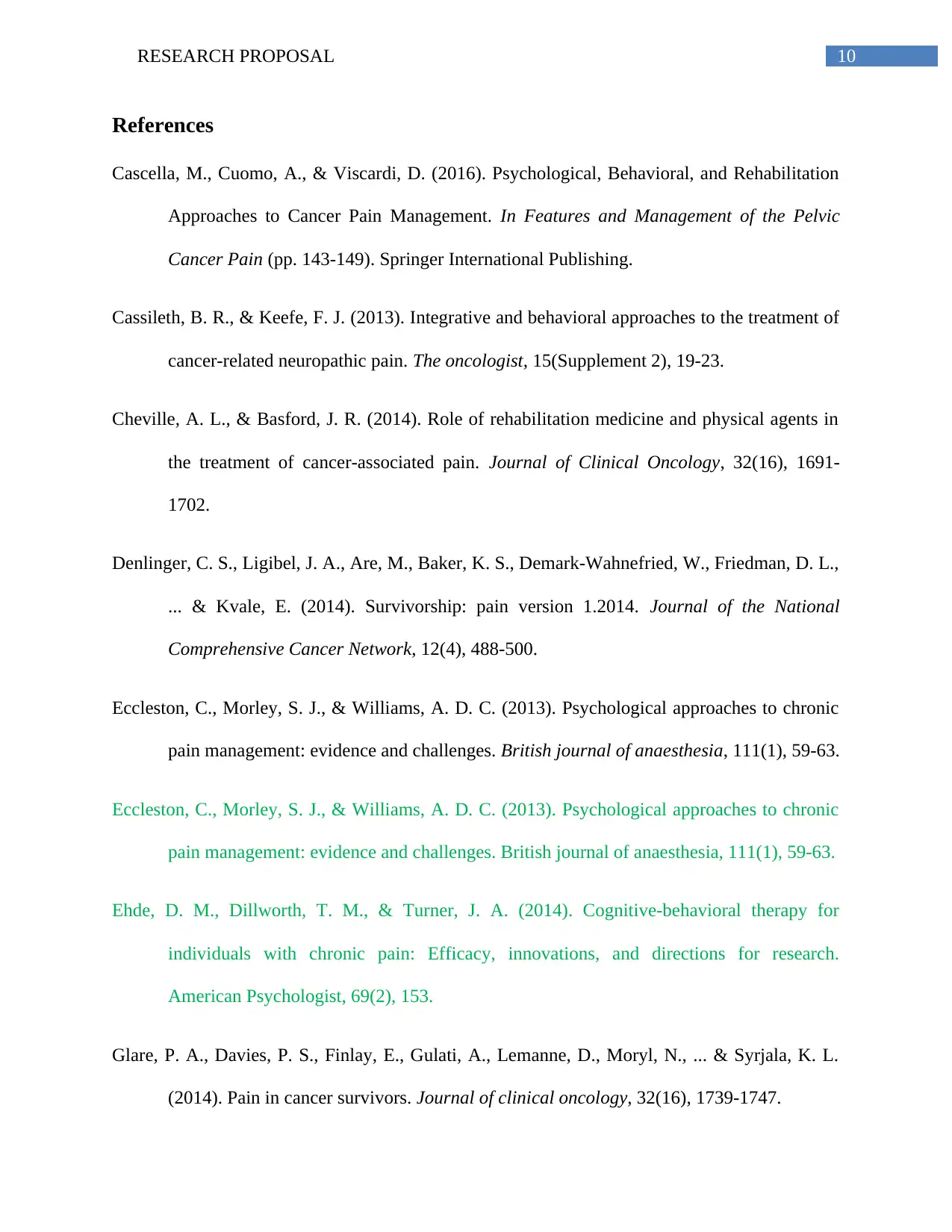
10RESEARCH PROPOSAL
References
Cascella, M., Cuomo, A., & Viscardi, D. (2016). Psychological, Behavioral, and Rehabilitation
Approaches to Cancer Pain Management. In Features and Management of the Pelvic
Cancer Pain (pp. 143-149). Springer International Publishing.
Cassileth, B. R., & Keefe, F. J. (2013). Integrative and behavioral approaches to the treatment of
cancer-related neuropathic pain. The oncologist, 15(Supplement 2), 19-23.
Cheville, A. L., & Basford, J. R. (2014). Role of rehabilitation medicine and physical agents in
the treatment of cancer-associated pain. Journal of Clinical Oncology, 32(16), 1691-
1702.
Denlinger, C. S., Ligibel, J. A., Are, M., Baker, K. S., Demark-Wahnefried, W., Friedman, D. L.,
... & Kvale, E. (2014). Survivorship: pain version 1.2014. Journal of the National
Comprehensive Cancer Network, 12(4), 488-500.
Eccleston, C., Morley, S. J., & Williams, A. D. C. (2013). Psychological approaches to chronic
pain management: evidence and challenges. British journal of anaesthesia, 111(1), 59-63.
Eccleston, C., Morley, S. J., & Williams, A. D. C. (2013). Psychological approaches to chronic
pain management: evidence and challenges. British journal of anaesthesia, 111(1), 59-63.
Ehde, D. M., Dillworth, T. M., & Turner, J. A. (2014). Cognitive-behavioral therapy for
individuals with chronic pain: Efficacy, innovations, and directions for research.
American Psychologist, 69(2), 153.
Glare, P. A., Davies, P. S., Finlay, E., Gulati, A., Lemanne, D., Moryl, N., ... & Syrjala, K. L.
(2014). Pain in cancer survivors. Journal of clinical oncology, 32(16), 1739-1747.
References
Cascella, M., Cuomo, A., & Viscardi, D. (2016). Psychological, Behavioral, and Rehabilitation
Approaches to Cancer Pain Management. In Features and Management of the Pelvic
Cancer Pain (pp. 143-149). Springer International Publishing.
Cassileth, B. R., & Keefe, F. J. (2013). Integrative and behavioral approaches to the treatment of
cancer-related neuropathic pain. The oncologist, 15(Supplement 2), 19-23.
Cheville, A. L., & Basford, J. R. (2014). Role of rehabilitation medicine and physical agents in
the treatment of cancer-associated pain. Journal of Clinical Oncology, 32(16), 1691-
1702.
Denlinger, C. S., Ligibel, J. A., Are, M., Baker, K. S., Demark-Wahnefried, W., Friedman, D. L.,
... & Kvale, E. (2014). Survivorship: pain version 1.2014. Journal of the National
Comprehensive Cancer Network, 12(4), 488-500.
Eccleston, C., Morley, S. J., & Williams, A. D. C. (2013). Psychological approaches to chronic
pain management: evidence and challenges. British journal of anaesthesia, 111(1), 59-63.
Eccleston, C., Morley, S. J., & Williams, A. D. C. (2013). Psychological approaches to chronic
pain management: evidence and challenges. British journal of anaesthesia, 111(1), 59-63.
Ehde, D. M., Dillworth, T. M., & Turner, J. A. (2014). Cognitive-behavioral therapy for
individuals with chronic pain: Efficacy, innovations, and directions for research.
American Psychologist, 69(2), 153.
Glare, P. A., Davies, P. S., Finlay, E., Gulati, A., Lemanne, D., Moryl, N., ... & Syrjala, K. L.
(2014). Pain in cancer survivors. Journal of clinical oncology, 32(16), 1739-1747.
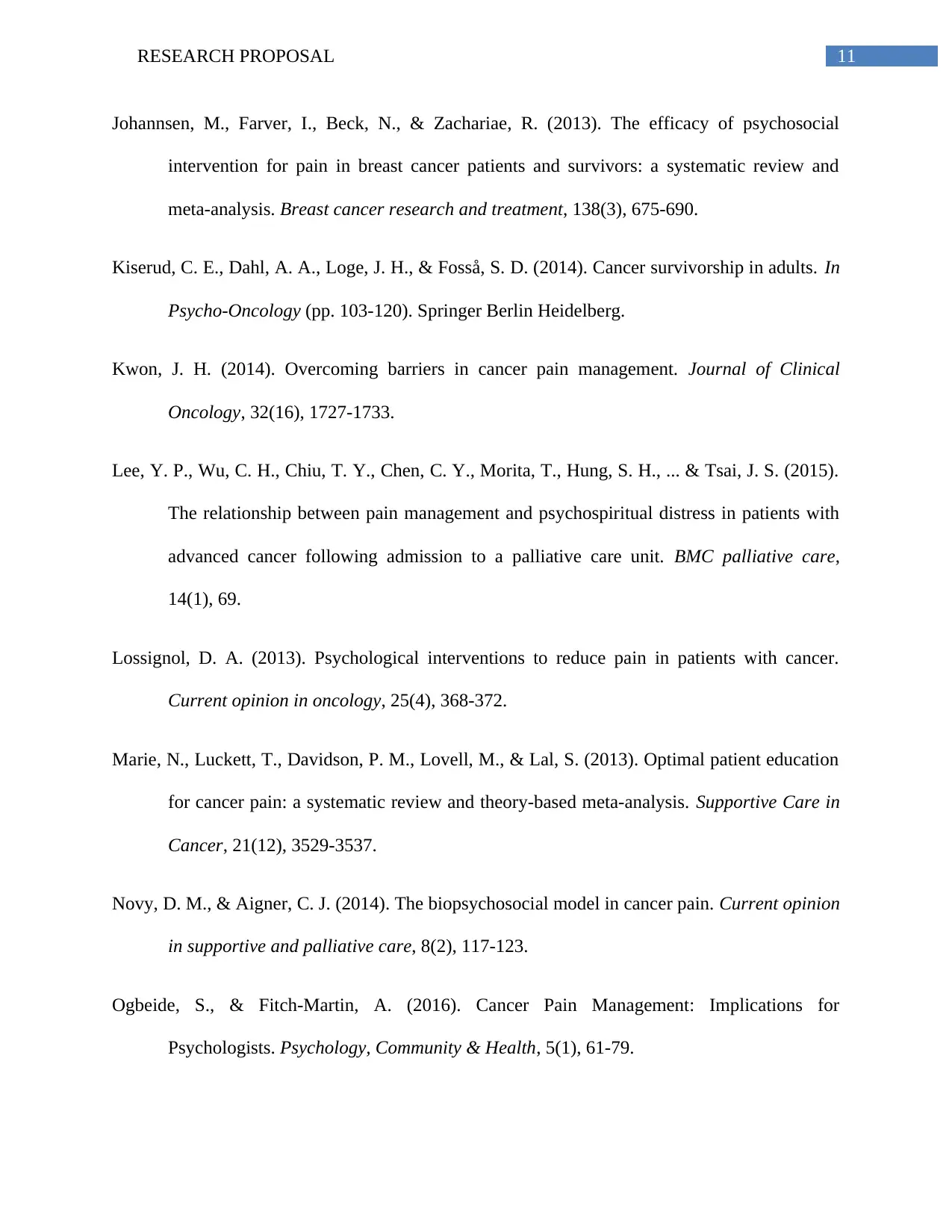
11RESEARCH PROPOSAL
Johannsen, M., Farver, I., Beck, N., & Zachariae, R. (2013). The efficacy of psychosocial
intervention for pain in breast cancer patients and survivors: a systematic review and
meta-analysis. Breast cancer research and treatment, 138(3), 675-690.
Kiserud, C. E., Dahl, A. A., Loge, J. H., & Fosså, S. D. (2014). Cancer survivorship in adults. In
Psycho-Oncology (pp. 103-120). Springer Berlin Heidelberg.
Kwon, J. H. (2014). Overcoming barriers in cancer pain management. Journal of Clinical
Oncology, 32(16), 1727-1733.
Lee, Y. P., Wu, C. H., Chiu, T. Y., Chen, C. Y., Morita, T., Hung, S. H., ... & Tsai, J. S. (2015).
The relationship between pain management and psychospiritual distress in patients with
advanced cancer following admission to a palliative care unit. BMC palliative care,
14(1), 69.
Lossignol, D. A. (2013). Psychological interventions to reduce pain in patients with cancer.
Current opinion in oncology, 25(4), 368-372.
Marie, N., Luckett, T., Davidson, P. M., Lovell, M., & Lal, S. (2013). Optimal patient education
for cancer pain: a systematic review and theory-based meta-analysis. Supportive Care in
Cancer, 21(12), 3529-3537.
Novy, D. M., & Aigner, C. J. (2014). The biopsychosocial model in cancer pain. Current opinion
in supportive and palliative care, 8(2), 117-123.
Ogbeide, S., & Fitch-Martin, A. (2016). Cancer Pain Management: Implications for
Psychologists. Psychology, Community & Health, 5(1), 61-79.
Johannsen, M., Farver, I., Beck, N., & Zachariae, R. (2013). The efficacy of psychosocial
intervention for pain in breast cancer patients and survivors: a systematic review and
meta-analysis. Breast cancer research and treatment, 138(3), 675-690.
Kiserud, C. E., Dahl, A. A., Loge, J. H., & Fosså, S. D. (2014). Cancer survivorship in adults. In
Psycho-Oncology (pp. 103-120). Springer Berlin Heidelberg.
Kwon, J. H. (2014). Overcoming barriers in cancer pain management. Journal of Clinical
Oncology, 32(16), 1727-1733.
Lee, Y. P., Wu, C. H., Chiu, T. Y., Chen, C. Y., Morita, T., Hung, S. H., ... & Tsai, J. S. (2015).
The relationship between pain management and psychospiritual distress in patients with
advanced cancer following admission to a palliative care unit. BMC palliative care,
14(1), 69.
Lossignol, D. A. (2013). Psychological interventions to reduce pain in patients with cancer.
Current opinion in oncology, 25(4), 368-372.
Marie, N., Luckett, T., Davidson, P. M., Lovell, M., & Lal, S. (2013). Optimal patient education
for cancer pain: a systematic review and theory-based meta-analysis. Supportive Care in
Cancer, 21(12), 3529-3537.
Novy, D. M., & Aigner, C. J. (2014). The biopsychosocial model in cancer pain. Current opinion
in supportive and palliative care, 8(2), 117-123.
Ogbeide, S., & Fitch-Martin, A. (2016). Cancer Pain Management: Implications for
Psychologists. Psychology, Community & Health, 5(1), 61-79.
⊘ This is a preview!⊘
Do you want full access?
Subscribe today to unlock all pages.

Trusted by 1+ million students worldwide
1 out of 13
Related Documents
Your All-in-One AI-Powered Toolkit for Academic Success.
+13062052269
info@desklib.com
Available 24*7 on WhatsApp / Email
![[object Object]](/_next/static/media/star-bottom.7253800d.svg)
Unlock your academic potential
Copyright © 2020–2025 A2Z Services. All Rights Reserved. Developed and managed by ZUCOL.





